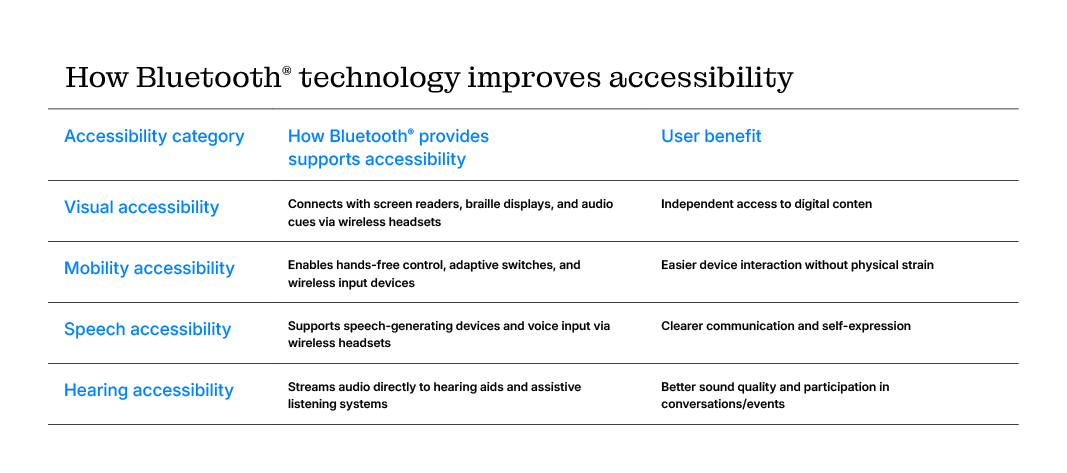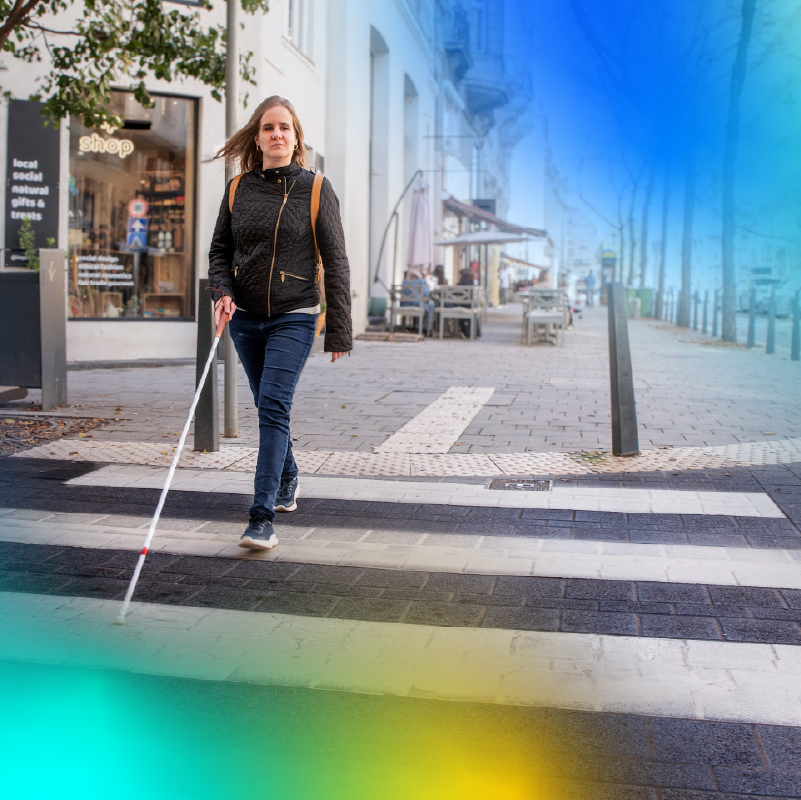According to the World Health Organization (WHO), 2.5 billion people require at least one assistive product to get through the day. Assistive products allow people to participate in more activities, regain their confidence, and enjoy a better life.
Bluetooth® technology continues to be essential in tearing down accessibility barriers, offering unique value to those faced with accessibility challenges. Its presence is ubiquitous across device types, it’s low power, and it has demonstrated the ability to support specific assistive applications.
ABI Research recently analyzed how Bluetooth® technology improves accessibility across visual, mobility, speech, and hearing accessibility.
Key takeaways
- Billions of people face accessibility challenges. These challenges impact an individual’s ability to see, move, speak, and hear. This can limit their career outlook, personal leisure, and social life.
- Bluetooth® technology helps remove accessibility barriers. Bluetooth® technology provides the wireless connectivity needed to design assistive products and enhance visitor experiences. Bluetooth® enabled screen readers, hearing aids, adaptive switches, and earbuds are common examples.
- Auracast™ broadcast audio is maturing. Auracast™ broadcast audio enables an audio stream to be sent to an unlimited number of nearby devices at the same time. This use case is revolutionizing assistive listening experiences, with the first public deployments materializing in 2025.

Why Bluetooth® connectivity pairs well with assistive products
Bluetooth® technology is embedded in a wide range of assistive products. Notable characteristics of Bluetooth® make it a popular choice:
- Low power consumption: Bluetooth® technology is ultra low power. This is beneficial for the many assistive products that are extremely small and have battery constraints.
- Ubiquitous presence in mobile and computing devices: Bluetooth® technology is already well-supported across all major device types. This ensures users can connect their assistive solution to their smartphone, PC, tablet, or other personal devices.
- In-ear audio readouts: Bluetooth® audio solutions provide discreet, in-ear guidance to users who have visual impairments. This could be directions to follow, a description of a museum piece, or similar details.
- Dedicated accessibility features: Bluetooth® features, such as Auracast™ broadcast audio, are designed to support specific accessibility use cases. There is strong potential for stadiums, convention centers, and other public venues to offer assistive products on a massive scale.
- Continued technology innovation: The Bluetooth Special Interest Group (SIG) remains at the cutting-edge of assistive technology. It continuously pushes the envelope in terms of innovation, ensuring Bluetooth® enabled devices meet the evolving needs of individuals faced with accessibility challenges.
- Diverse member ecosystem: There are many Bluetooth® IC vendors and other solution providers on the market. This competitiveness accelerates technological advancements as device manufacturers aim to differentiate themselves.

How does Bluetooth® support visual accessibility?
Bluetooth® technology is well-suited to assist the 2.2 billion people faced with vision challenges. Products such as Bluetooth® screen readers, braille displays, wearable devices, and smart glasses deliver on a wide range of accessibility-related applications.
- Bluetooth® screen readers: Bluetooth enabled screen readers provide text-to-speech capabilities. For example, they can read restaurant menus aloud for users with visual impairments.
- Bluetooth® braille displays: People with visual accessibility challenges can use a Bluetooth braille display to read text, documents, and other information from their personal devices. Newer braille solutions can even pull information from charts, photos, floor plans, and other non-text visuals.
- Bluetooth® wearable navigation devices: Wearable devices, such as headsets and smart belts, leverage camera and machine learning technology to identify obstacles, describe the surrounding environment, and provide directions to a destination.
- Bluetooth® smart glasses: Smart glasses are designed to eradicate accessibility limitations. Bluetooth connectivity ensures that smart glasses support text-to-speech applications, automatic vision focus adjustment, and a companion app.
How does Bluetooth® support mobility accessibility?
Millions of people face mobility challenges every day, which can drastically reduce overall quality of life. Bluetooth® technology enables these individuals to live more independently and participate in a broader range of activities.
- Bluetooth® enabled wheelchair control systems: Bluetooth technology is leveraged in many wheelchairs and wheelchair control systems to make phone calls, send emails, control smart home devices, and complete other daily tasks. This reduces reliance on caregivers and increases the number of leisure activities that an individual can participate in.
- Assistive switches: Users of Bluetooth® enabled assistive switches have a means of controlling computing devices and interacting with their environment.
- Game controllers: Bluetooth® technology supports wireless connectivity between gaming accessories and the console/PC, allowing users can customize their controller’s joystick settings, sensitivity, and other characteristics.
- Wearables and electromyography (EMG) devices: A number of medical solutions are equipped with Bluetooth® technology to enable individuals faced with physical challenges to control devices and communicate. These innovative technologies interpret user intention based on gestures and muscle movement.
- Bluetooth® Mobility Aids: Mobility aids such as exoskeletons, prosthetics, and bionics leverage Bluetooth technology to wirelessly connect with companion apps. These solutions alleviate physical strain and assist in daily tasks like typing on a keyboard and carrying groceries.
How does Bluetooth® support speech accessibility?
Bluetooth technology supports speech accessibility through a variety of speech-generating devices. Users with MND, aphasia, and other speech-hindering conditions can use Bluetooth enabled devices to send messages and emails and make phone calls with a synthetic voice.
The National Institute of Health reports that roughly one out of ten adults in the United States has a speech, language, and/or voice disability. Bluetooth assistive devices help these individuals by gauging a user’s intention based on eye tracking and other physical signals. Furthermore, text-to-speech software gives a voice to those who previously did not.
How does Bluetooth® support hearing accessibility?
About one in five people globally are hard of hearing, and Auracast™ broadcast audio, a new Bluetooth feature, is increasingly being integrated into assistive listening products to address this health issue. Auracast™ transmitters allow for a high-quality audio broadcast to be sent to an unlimited number of nearby receivers simultaneously. This feature is highly beneficial for public venues, transportation hubs, and other places with a high population density and the need for effective communications. Auracast™ broadcast audio is also increasingly supported in home entertainment products such as TVs and true wireless earbuds.
According to ABI Research, roughly 3.5 billion Bluetooth® LE Audio-enabled devices will ship annually by 2030, with Auracast™ broadcast audio being a standard feature.
ABI Research has observed a significant build-up of Auracast™ enabled products and deployments over the last 12 months.
- Hearing aids: Auracast™ broadcast audio is now widely supported by hearing aid manufacturers.
- Traditional receiver devices: Auracast™ broadcasts transmit top-notch audio to a user’s headphones or earbuds. For users who may feel uncomfortable wearing a hearing aid or only suffer from mild hearing loss, this Auracast™ use case is a viable alternative.
- Personal and in-home transmitters: Sony, Samsung, and many other leading consumer technology companies support Auracast™ broadcast audio in newer products. This is creating exciting new customer experiences and retrofit opportunities.
- Public venues: ABI Research estimates that more than 60 million venues globally could benefit from Auracast™ broadcast audio. Venues include places of worship, stadiums, transportation hubs, theatres, etc. Sydney Opera House, Bristol Temple Meads Station, and the Grace Lutheran Church are notable early adopters of Auracast™ broadcast audio.
- Countertop transmitters: Down the line, one-to-one deployments of Auracast™ broadcast audio will be a leading use case, enabling users to have a private conversation at public service counters and reception desks.
- Tour guides: Auracast™ broadcast audio solutions enable users to tune into an audio tour system at museums, tourist attractions, and similar venues.
Learn more
Bluetooth® connectivity isn’t just for listening to music or pairing with gaming accessories. It plays a vital role in helping those faced with accessibility challenges to gain access to more services, engage in activities, and improve their quality of life.
Learn more about how Bluetooth technology and advanced features like Auracast™ broadcast audio leave a positive mark on the world by reading the latest market research note: When connection becomes inclusion: How Bluetooth® is redefining accessibility.
世界保健機関(WHO)によると、現在約25億人が日常生活を送る上で、少なくとも1つの支援デバイスを必要としています。これらの支援デバイスは、活動の参加を広げ、自信を取り戻し、より良い生活を後押しします。
Bluetooth®技術は、アクセシビリティに関する障壁を取り除く上で欠かせない存在です。多様なデバイスへの普及、低消費電力、そして具体的な支援用途への実装実績を通じ、アクセシビリティに課題を抱える方々に特別な価値を提供しています。
ABI Researchでは、視覚・移動・発話・聴覚の各分野において、Bluetooth®技術がどのようにアクセシビリティを支援しているかについて分析を行いました。
主な調査結果
- 数十億人がアクセシビリティの課題に直面
視覚、移動、発話、聴覚といった能力の制限は、職業選択、余暇活動、社会生活の機会を制限する可能性があります。 - Bluetooth®技術はアクセシビリティの障壁を取り除く無線基盤を提供
Bluetooth 対応のスクリーンリーダー、補聴器、アダプティブスイッチ、イヤホンなど、さまざまな支援デバイスが登場しています。これらの製品は、個人の行動や体験を拡張する重要なツールです。 - Auracast™ ブロードキャスト オーディオの実用化が進展
Auracast™ブロードキャストオーディオは、近くのデバイスに同時かつ台数制限なく音声を配信できる新技術です。2025年に公共施設での導入が始まり、聴覚補助の在り方を根本から変えつつあります。
Bluetooth®技術によるアクセシビリティ向上
| アクセシビリティ分類 | Bluetooth®によるアクセシビリティ機能 | ユーザーのメリット |
| 視覚に関するアクセシビリティ | スクリーンリーダー、点字ディスプレイ、ワイヤレスヘッドセットで聞く音声キュー | デジタルコンテンツに自分でアクセスできる |
| 移動に関するアクセシビリティ | ハンズフリー操作、アダプティブスイッチ、ワイヤレス入力デバイス | 身体に負担をかけることなくより簡単にデバイスを操作できる |
| 発話に関するアクセシビリティ | 音声生成デバイス、ワイヤレスヘッドセットを使用した音声入力 | より明確なコミュニケーションと自己表現ができる |
| 聴覚に関するアクセシビリティ | 補聴器や聴覚補助システムに直接音声をストリーミング | より良い音質で会話/イベントに参加できる |
Bluetooth®技術が支援デバイスと相性がいい理由
Bluetooth®技術は、さまざまな支援デバイスに搭載されています。その人気の理由は、以下の特性にあります。
- 低消費電力:Bluetooth®技術は極めて低消費電力で、小型・軽量でバッテリー制約のある支援デバイスに理想的です。
- 高い普及性: 主要なスマートフォン、PC、タブレットなど、ほぼすべてのモバイルデバイスに標準搭載されており、支援デバイスとの互換性を確保します。
- 音声によるガイダンス:Bluetooth®オーディオ機能により、視覚障害を持つ人々に対して、周囲に気付かれずに情報を耳元で伝えることが可能です。道案内や美術館の展示説明など、生活に密着した支援が実現します。
- アクセシビリティ専用機能:Auracast™ ブロードキャスト オーディオのような機能は、特定の支援ユースケースに対して設計されています。スタジアム、コンベンションセンターなどの公共施設で、多数の利用者に同時に支援サービスを提供できる可能性があります。
- 継続的な技術革新:Bluetooth SIG(Special Interest Group)は支援技術分野の最前線にたち、ユーザーのニーズの変化に対応するための革新を絶えず推進しています。
- 活発なエコシステム:多数のBluetooth® ICベンダーやソリューションプロバイダーが参加するオープンな市場が、技術革新と製品多様化を後押ししています。

視覚アクセシビリティを支えるBluetooth®
世界で22億人が視覚に関する課題を抱えており、Bluetooth®技術はそれらを支援する多様な製品で活用されています。Bluetooth®スクリーンリーダー、点字ディスプレイ、ウェアラブルデバイス、スマートグラスなどが、アクセシビリティ関連の幅広い用途に提供されています。
- Bluetooth®スクリーンリーダー :テキストを音声に変化して読み上げる機能を備え、メニューやドキュメントなどの情報を音声で提供します。
- Bluetooth®点字ディスプレイ:スマートフォンやPCと接続してテキストを点字化。最新モデルでは、図表や写真など非テキスト情報の触覚出力も可能です。
- Bluetooth®ウェアラブルナビゲーション:ヘッドセットやスマートベルトなどのウェアラブルデバイスが、カメラとAIを用いて障害物や音声ガイドします。
- Bluetooth®スマートグラス:スマートグラスはアクセシビリティに由来する制約を取り除けるように設計されています。Bluetooth接続により、スマートグラスが読み上げ機能やオートフォーカス機能を提供し、専用アプリが使用できることが保証されます。
移動アクセシビリティを支えるBluetooth®
日常的な移動に困難を感じる人は世界中に何百万人います。Bluetooth®技術は、自律した生活や社会参加を後押しします。
- Bluetooth®搭載車椅子制御システム:電話、メール、スマートホーム操作などをワイヤレスで行い、介護者への依存を減らします。
- Bluetooth®支援スイッチ:Bluetooth®支援スイッチは、パソコン操作や周囲の環境と関わる手段を提供します。
- Bluetooth®ゲームコントローラー:Bluetooth®技術はゲーム周辺機器とゲーム機やパソコンとをワイヤレスにつなぎ、ジョイスティック設定や感度やボタン配置を自由に設定し、誰でも簡単に操作できる環境を実現します。
- ウェアラブル&EMG(筋電位)デバイス:Bluetooth®技術を搭載した医療機器もあり、身体的な障害のある人のデバイス操作やコミュニケーションに使用されています。筋肉の動きやジェスチャーを検出し。機器の操作や意思伝達を支援します。
- Bluetooth®モビリティ支援デバイス:外骨格や義肢、バイオニックデバイスなどがBluetoothを介してアプリと連携。身体への負担を緩和し、キーボードを打つ、買い物した荷物を運ぶなどの日常生活の動作を補助します。
発話アクセシビリティを支えるBluetooth®
Bluetooth技術は、さまざまな音声生成デバイスを通じて発話支援のアクセシビリティを支援しています。MND(運動ニューロン疾患)や失語症など、発話に障害がある場合、Bluetoothデバイスを使用してメッセージやメールを送ったり、合成音声を使って電話をかけたりすることができます。
米国国立衛生研究所(NIH)の報告書によると、米国の成人の約10人に1人が発話、言語、発声に障害を抱えています。Bluetooth支援デバイスは、アイトラッキングやその他の身体的な合図に基づいてユーザーの意図をくみ取り、支援します。また、読み上げソフトウェアによって、これまで発話することができなかった人が音声で話すことができるようにもなります。
聴覚アクセシビリティを支えるBluetooth®
世界の約5人に1人が難聴を抱えています。Bluetoothの新機能Auracast™ブロードキャストオーディオが、聴覚補助デバイスに搭載する動きが広がっています。Auracast™送信機を使用すれば、高音質のオーディオブロードキャストを、台数制限なく近くの受信機に同時送信できます。この機能は公共施設や交通拠点をはじめ、人が集まり、効果的な情報伝達手段を必要とする場所で効力を発揮します。Auracast™ブロードキャストオーディオは、テレビなどのホームエンターテインメント機器や完全ワイヤレスイヤホンなどでも搭載が増えています。
ABI Researchによると、2030年のBluetooth® LE Audio搭載デバイスの年間出荷台数は35億台に達します。Auracast™ブロードキャストオーディオはこれらの機器に標準搭載されることになります。
ABI Researchでは、過去12カ月にAuracast™対応製品や設備導入の大幅な拡大を観測しています。
- 補聴器:多くの補聴器メーカーが幅広くAuracast™ブロードキャストオーディオを採用しています。
- 従来型の受信機:Auracast™では最高級の音質のオーディオをイヤホンやヘッドホンに送信します。補聴器の装用に抵抗がある場合や難聴が軽度である場合に活用できます。
- 個人用/家庭用送信機:Sony、Samsungをはじめ、数多くの主要コンシューマーテクノロジー企業の新製品にAuracast™ブロードキャストオーディオが搭載されています。これらの製品は心躍るような新しいユーザー体験を生み出すほか、後付けも可能です。
- 公共施設:ABI Researchは、Auracast™ブロードキャストオーディオによるメリットを見込める施設が世界に6000万箇所以上あると見込んでいます。具体的には、礼拝施設、スタジアム、交通拠点、劇場などがあります。Auracast™ブロードキャストオーディオをいち早く導入した施設には、シドニー・オペラハウス、ブリストル・テンプル・ミーズ駅、グレース・ルーテル教会などがあります。
- サービスカウンター用送信機:将来的には、Auracast™ブロードキャストオーディオを1対1で使用する、サービスカウンターや受付デスクでの利用が主要なユースケースの一つになります。
- ツアーガイド:Auracast™ブロードキャストオーディオは、美術館や観光施設などの音声ツアーに活用できます。
さらに知る
Bluetooth®接続は音楽を聞いたり、ゲーム周辺機とペアリング接続したりするためだけのものではありません。アクセシビリティの課題に直面する人々がより多くのサービスを利用し、活動に参加し、QOL向上を図る上で極めて重要 な役割を担っています。
Bluetooth技術とAuracast™ブロードキャストオーディオなどの先進技術が世界をどのように良い方向に変えているかについてさらに知るには、市場調査レポート「つながりで実現する、誰もが参加できる社会――Bluetooth®が変革するアクセシビリティの未来」をご覧ください。